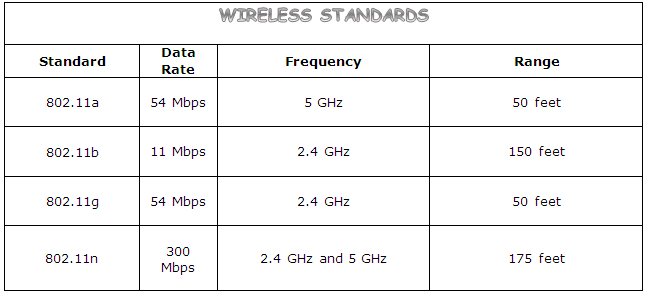Networking Basics - Certifications - Windows 7 - Windows 8 - Home Network Setup - Wireless Setup :: About - Contact - Search
Wireless Networking Basics
Part 1 - Introduction.....
This page on wireless networking basics will teach you some of the advantages of having a wireless network at home or business.
A wireless network uses radio signals instead of CAT5 Ethernet cable or other standard wiring methods. The idea is to broadcast your data and information without having wires run all over your house or business.
Advantages:
- Convenience of Mobility – (laptops, tablets and cell phones can connect anywhere in range)
- No cable runs around your house or business (cabling can be hard work and look messy)
- Flexibility to add desktops and wireless printers anywhere you like in the house as long as you are in range
Disadvantages:
The wireless network is also called Wi-Fi and WLAN.
Wireless Networking Basics: Wireless Standards for more speed and range
The following chart shows the wireless standards:

The newest wireless standard is 802.11n and it is the most popular. This wireless standard is the fastest and covers the most range in distance. You should consider buying a wireless router and wireless adapter that are 802.11n compatible to take advantage of their better features.
802.11n adds a technology called multiple-input multiple-output (MIMO). This is a signal processing and smart antenna technique for transmitting multiple data streams through multiple antennas. In basic terms, this means you can get 5 times the performance and up to twice the range compared to 802.11g standard.

Some locations like McDonald’s, Starbucks and airports provide a service called WI-FI hotspot. What this means is that you can have your laptop, cell phone and tablet search for their wireless signal (hotspot) in range and connect to it. McDonald’s and Starbucks both offer free WI-FI connections. Most airports will allow you to connect to their hotspot and the first webpage to come up in your browser would be a payment options page. This page will allow you to buy time limits for using the Internet.
In your home, you usually have a DSL/Cable modem which connects to your own wireless router that you would buy. Most Internet Service Providers like AT&T and Comcast will provide you with a wireless DSL/Cable modem if you ask for it.
Why setup a wireless network instead of a wired network?
It is hard to find a reason to setup your home or business with a wired installation since the current speeds and range that 802.11n provide are enough. The one major benefit of having your home or business with a wired setup is for security. Some businesses have sensitive data that they don’t want their wireless signal broadcasting for anyone to see. Today you can argue that the wireless routers have improved security.
Click here for tips on securing your wireless network.
Most routers allow you to choose and configure which data encryption protocol you want to use.
The most common types of wireless security are:
Move on to the next section and we will learn about these protocols which can secure your wireless network.
Part 1.) Wireless Networking Basics (You are here)
Part 3.) Tips for securing your wireless network at home or business
<- - -Go back to "Ethernet Tutorial"
Return from Wireless Networking Basics to Computer Networking Basics
Return from Wireless Networking Basics to homepage of Computer Networking Success
"Didn't find what you were looking for? Use this search feature to find it."

1













New! Comments
Have your say about what you just read! Leave a comment in the box below.